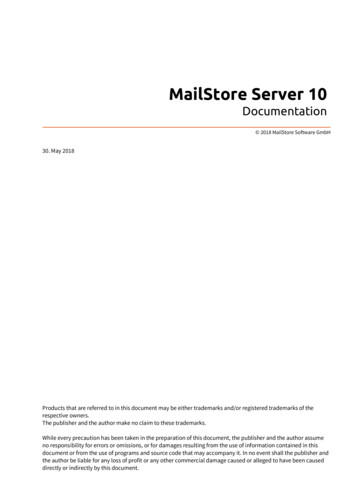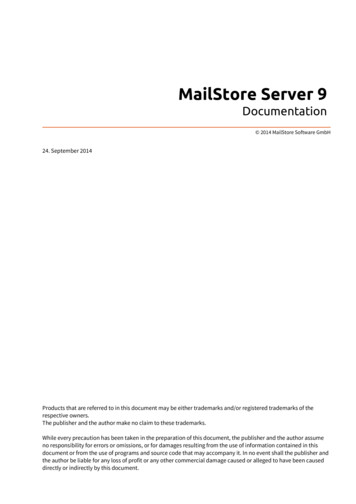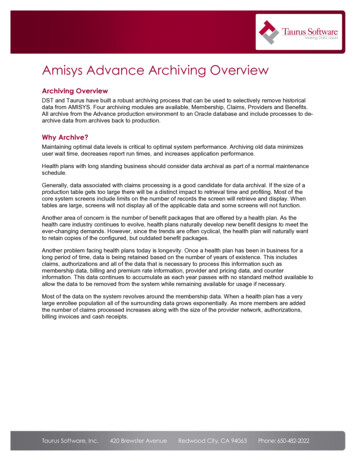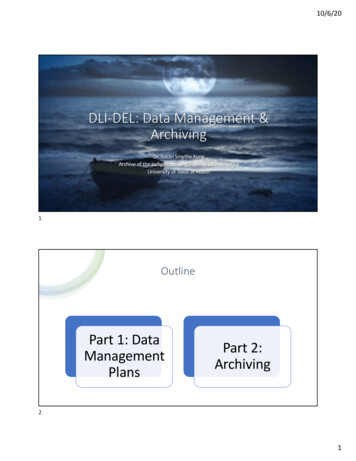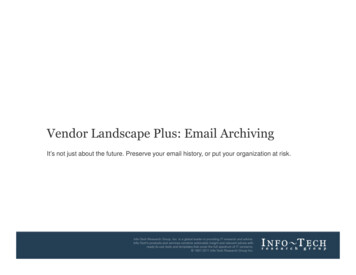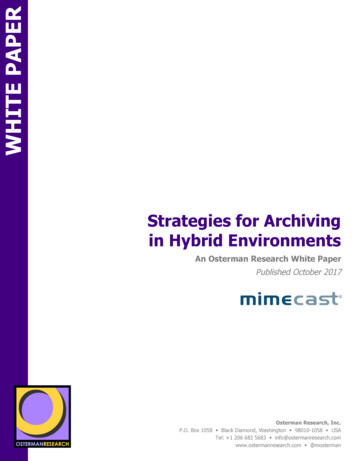
Transcription
WHITE PAPERStrategies for Archivingin Hybrid EnvironmentsONAn Osterman Research White PaperPublished October 2017SPONsponsored bysponsored bysponsored byOsterman Research, Inc.P.O. Box 1058 Black Diamond, Washington 98010-1058 USATel: 1 206 683 5683 info@ostermanresearch.comwww.ostermanresearch.com @mosterman
Strategies for Archiving inHybrid EnvironmentsEXECUTIVE SUMMARYThere are five primary drivers for the growing use of hybrid archiving solutions, inwhich organizations store some of their content on-premises and some in the cloud:1.An increasing proportion of electronic content is being generated and stored inthe cloud, including new content types – such as social media, online and textmessages – that previously were archived only rarely.2.A growing number of cloud archiving vendors offer robust solutions that offerperformance that is often better than legacy on-premises solutions whenaccounting for security procedures, hardware/software/infrastructure currency,disaster recovery, provisioning and performance.3.Decision makers are becoming more comfortable with the notion of storingessential business content in cloud archives.4.Despite the rapid shift toward cloud-based archiving solutions, existing onpremises archiving solutions, including legacy solutions, still offer significantvalue and will continue to play a role in corporate archiving strategies for manyyears to come. Aging off content often makes more sense than migrating it to anew software/delivery provider.5.The development of a unified archiving solution that will permit the search andproduction of information from both on-premises and cloud-based archivingplatforms offers a number of important advantages compared to just one or theother solution.KEY TAKEAWAYS Organizations archive electronic content for a variety of reasons, but most oftenbecause of their regulatory, legal or contractual requirements to retain data forspecified periods, their need to comply with various industry regulations, forpurposes of disaster recovery or business continuity, and to retain data foreDiscovery. Decision makers are adopting cloud-based archiving solutions at a much fasterpace than their on-premises counterparts, although the latter will continue to bean essential component of most organizations’ archiving strategies for at leastthe next several years. A plurality of decision makers view a hybrid archiving approach – as opposed tousing only an on-premises archiving system or a cloud-based solution – aspreferable for some of their most important content management requirements,such as satisfying their regulatory obligations, maintaining 24x7 access to theirarchives, and minimizing the cost of maintaining an archiving system. Decision makers are of two minds with regard to archiving: while 40 percent ofdecision makers believe that on-premises archiving solutions are more securethan those in the cloud, the majority believe that cloud-based archiving is atleast as secure as on-premises systems, if not more so. This tells us that botharchiving delivery models will continue to thrive, but with an increasing focus oncloud archiving.Decisionmakers arebecomingmorecomfortablewith thenotion ofstoringessentialbusinesscontent incloudarchives.ABOUT THIS WHITE PAPERThis white paper discusses the key issues facing corporate decision makerssurrounding archiving requirements and the location of their data. The paper alsodiscusses some of the results of an in-depth survey of content archiving decisionmakers and influencers in mid-sized and large organizations that was conductedduring August 2017. 2017 Osterman Research, Inc.1
Strategies for Archiving inHybrid EnvironmentsThis paper was sponsored by Mimecast – information about the company is providedat the end of the paper.LEADING DRIVERS FOR ARCHIVINGThe drivers for archiving electronic content in a particular organization depend on anumber of factors, including its corporate culture, senior management’s appetite forrisk, the regulatory obligations it faces, the geographies in which it operates, and avariety of others.The survey conducted for this white paper asked decision makers and influencers torate the various drivers for electronic content archiving on a scale of 1 (not a driver)to 7 (a major driver), and also how these were changing over time. As shown inFigure 1, the most important drivers in 2017 are legal and contractual requirementsto retain data for specified periods, regulatory compliance obligations, disasterrecovery/business continuity, and eDiscovery.Figure 1Drivers for Maintaining an Archiving Solution, 2017 and 2019Percentage Indicating an Important or Major DriverSource: Osterman Research, Inc.While all of the drivers for archiving electronic content will become more importantover the next two years, two findings from the research are noteworthy:1.While eDiscovery is today a fourth-place driver (albeit a close fourth place) forarchiving, it will become tied for the most important driver in just two years’time.2.The drivers for archiving that will grow in importance most quickly over the nexttwo years are extracting insight and intelligence from archived data (growing inimportance as a key driver by 50 percent) and giving employees the ability tosearch for their old content (33 percent). Admittedly, these are the leastimportant motivators today for organizations to archive their electronic content,but a growing number of decision makers understand the importance of usingtheir archived content for new and imaginative applications to businessproblems. 2017 Osterman Research, Inc.2
Strategies for Archiving inHybrid EnvironmentsOsterman Research is a supporter of the view that archiving should be used as a toolto gather intelligence about an organization and gain competitive or other advantagesbased on the insight gleaned from this information. For example, a huge amount ofinformation is stored in data archives, such as emails, spreadsheets, social mediaposts, memos, graphics files, presentations, voicemails, contacts, databases, CRMdata and other data types. This content is generated by and stored in a wide varietyof venues. The traditional view of archiving will preserve this content in the event it isneeded in the future – a proactive view of archiving will perform analytics on thiscontent to search for meaningful insights that can be extracted from it.LEGAL AND CONTRACTUAL REQUIREMENTSOrganizations are subject to a host of legal and contractual requirements, and mustmanage their eDiscovery process and control the costs associated with eDiscovery.Every organization – regardless of its size, the industry it serves or how much data itpossesses – must retain important records for various lengths of time. Therequirement to retain data is imposed from a variety of sources, including legalprecedent (courts establish standards for the length of time that data must beretained), statutory obligations ( specifically defining the retention and productionobligations for certain types of data), and internal best practices. Retentionobligations apply to all forms of data, both physical and electronic. Organizations thatreasonably anticipate pending litigation may also need to subject certain electroniccontent to a legal hold period that is different from their standard policies. Acentralized archive can facilitate that process.If eDiscovery is managed using a centralized and properly maintained archive,organizations are generally much more capable of addressing their litigationrequirements and controlling the costs associated with those activities. In addition,for organizations that have frequent or extensive litigation or investigations,proactively addressing eDiscovery in a systematic way can significantly reduce overalleDiscovery expenses and other costs of litigation.Easy search and access to electronic records, particularly across the multiple siloes inwhich an organization’s data is stored, can permit legal counsel to evaluate the meritsof a case before investing substantial time, money and effort in electronic recordsretrieval. In short, legal counsel and senior management can make better decisionsabout whether to fight or settle a lawsuit by having easy access to all archivedcontent.REGULATORY COMPLIANCEA large proportion of the electronic records that pertain to an organization’s businessactivities are subject to regulatory compliance obligations, which vary by industry andjurisdiction. It is important to note that virtually every organization and industry facessome level of regulatory compliance obligation to retain its records, and thatretention obligations are not limited to “regulated” organizations or industries, sincethere is no such thing as an “unregulated” one. A few examples of data retentionrequirements outside of industries that are normally considered to be “heavilyregulated”: US and foreign air transport carriers must retain for three years the complaintsthey receive from individuals with disabilities who use these carriers.1 Employers of homeworkers in the clothing, jewelry and related industries mustretain for three years any documents related to stop watch time studies or otherwork measurement methods used to demonstrate piece rates so that theseemployers can prove that employees are making at least minimum wage.212Everyorganization –regardless ofits size, theindustry itserves or howmuch data itpossesses –must retainimportantrecords forvariouslengths oftime.14 CFR 382.15729 CFR 530.202 2017 Osterman Research, Inc.3
Strategies for Archiving inHybrid Environments Bottlers involved in the labeling and advertising of distilled spirits must retain forfive years certificates of age and/or origin for spirits imported to the US in bulkwhere those spirits are bottled and removed from the plant.3These regulations require the retention of content such as financial documents, emailcorrespondence between organizations, employee records, invoices, shippinginformation and a variety of other data. In fact, even metadata must be preserved –the Supreme Courts of both Arizona and Washington State have ruled that metadatamust be retained along with other records.Among the more heavily regulated verticals worldwide is the financial servicesindustry. In the United States, for example, rules of the Securities and ExchangeCommission (SEC) and the Financial Industry Regulatory Authority (FINRA) requiremembers of national securities exchanges, brokers and dealers to preserve securitiestransaction records for a minimum of six years, the first two years in an easilyaccessible place. In Canada, records of purchase and sell orders of securities must beretained for seven years, the first two years in an easily accessible location. And inthe United Kingdom, investment service and transaction records must be retained forat least five years.The consequences to financial services firms of not complying with these retentionregulations can be severe and typically involve the imposition of significant financialpenalties.Another heavily regulated industry is healthcare. For example, the Health InsurancePortability and Accountability Act of 1996 (HIPAA), requires organizations to protectpatients’ electronic health information from unauthorized users and to retain suchinformation for six years. Non-compliance with HIPAA requirements could result infines of up to 50,000 per violation, or criminal penalties of 250,000 and up to 10years in prison for violations based on intent or malice.Virtually every organization, even in industries which are not considered heavilyregulated, are subject to electronic content retention requirements and theconsequences of non-compliance with requirements, as discussed above.THE GDPRAside from the enormous fines associated with violation of the European Union’sGeneral Data Protection Regulation (GDPR) – up to 20 million or four percent of anorganization’s annual turnover – there are some important implications to considerfor organizations that possess data on residents of the EU. For example: Article 15 of the GDPR gives data subjects the right to ask any entity thatpossesses or processes his or her personal data (a data controller) to producethat data on demand. These individuals also have the right to know if and whentheir data is transferred to a third country or to an international organization,along with whatever safeguards are in place to ensure on-going protection of thedata after it has been transferred. A data controller must provide a copy of anypersonal data that is being processed at no charge the first time it is requested. Article 17 states that, subject to certain conditions, a data subject has the “rightto be forgotten” by any data controller that possesses or controls his or herinformation. Article 30 requires that data controllers keep records of their data processingactivities, with a list of specific information to be retained for each record.327 CFR 5.56 2017 Osterman Research, Inc.4
Strategies for Archiving inHybrid EnvironmentsMoreover, implementing the right organizational and technological safeguards on allproduction systems that contain personal and sensitive personal data is essential, butit isn’t enough. Sufficient controls are required for: Copies of production databases that contain personal data taken for testing,development, or analytics purposes. Spreadsheets and other data sources populated by exporting customer contactand profiling details for a mail merge. Email archives, whether stored on-premises, in cold storage or in the cloud arelikely to contain personal data that must be protected under the GDPR.The GDPR imposes a major burden on any organization that has data on residents ofthe European Union, requiring a level of data retention and management that is onpar with the level of effort required for eDiscovery activities. Plus, these activitiesmust often be performed without charging those who request information, and soarchiving and related activities must be efficient and easy to use. In short,compliance with many of the key provisions of the GDPR will not be possible withouta robust archiving capability.STORAGE MANAGEMENT AND PERFORMANCEAn archiving system can help enable storage management by indexing content andmaking it more accessible and discoverable. This is particularly important fororganizations that must respond to frequent retrieval requests for email and filesbecause it can dramatically reduce the time employees spend looking for, filteringand producing data. Sunshine-law and Freedom of Information Act (FOIA) requestsare two common types of requests, but there are numerous others.An archiving system can also improve email and other system performance byminimizing the amount of “live” data that must be stored on active servers. Becauseelectronic data like old email messages and files older than 30 days are accessedrelatively infrequently, it often makes sense to move this content to an archivingsystem for better system performance. This can reduce the amount of time requiredto backup email and data servers, it can speed the time to restore a server frombackups, and it can reduce the amount of overall downtime experienced in keysystems.KNOWLEDGE MANAGEMENT AND END-USER SELF-SERVICEACCESS TO CONTENTAn organization’s email and other electronic content constitute one of its mostimportant business knowledge repositories. Some analysts have estimated that themajority of an organization’s intellectual property is contained in its messagingsystems. Even if that is overstated, an organization’s electronic content does containimportant (structured and unstructured), employee-generated information critical toits growth, ongoing operations and profitability, competitive advantage, and its abilityto innovate.The driversand needs forarchiving arechanging overtime ronments,must be ableto adapt.To satisfy employees’ constant need for business information, email, collaborationtools and other electronic content repositories are often relied upon as the primarytools used for work. For example, an employee may need to locate stored emailsquickly so he or she can review their own email correspondence or other content,such as attachments, in email. Alternatively, a new employee may have to trace backemail and other electronic content between his or her predecessor and a customer.Employees are also extracting business intelligence and data from electronic contentservers. This makes the preservation and availability of the content extremelyimportant. An organization that does not store its important content adequately risksthe loss of information that it has paid employees to create. 2017 Osterman Research, Inc.5
Strategies for Archiving inHybrid EnvironmentsTHE DRIVERS ARE CHANGING OVER TIMEThe drivers and needs for archiving are changing over time and organizations,including those operating hybrid environments, must be able to adapt. For example,cyber security has emerged as a driver for archiving and for preserving content frombad actors or those seeking to deploy malicious cyber attacks.Regulations are evolving and archiving requirements are typically getting morestringent. Newer regulations like the European Union’s General Data ProtectionRegulation (GDPR) and the New York Department of Financial Services (NYDFS)implementation of Cyber security Requirements for Financial Services Companies(CRFSC) are two examples of the changing nature of the archiving challenge.HOW ARCHIVING IS EVOLVINGThe survey of decision makers and influencers looked at the types of electroniccontent that organizations archive today and where that content resides. Notably, asshown in Figure 2, a high percentage of corporate email on-premises (61 percent),users’ files (61 percent), invoices (58 percent), security audit logs (52 percent), andproject data (48 percent) are all archived on-premises. Not surprisingly, corporateemail in the cloud tends also to be archived in the cloud (56 percent). In addition,slightly more than 20 percent of both user files and on-premises email are stored inthe cloud.Figure 2Types and Methods of Electronic Content Archiving, 2017 and 2019Based on Percentage of Organizations2017Content TypeCorporate email onpremisesUsers' filesInvoicesSecurity audit logsProject dataContent fromSharePoint or similarcollaboration toolsWeb pagesVoicemails from thecompany phonesystemMachine-generateddataContent fromcompany-ownedmobile devicesCompany-managedfile sync and sharecontentCorporate IM contentCorporate email inthe cloudVoice conversations(not voicemail)Work-related contentfrom employees' IMaccounts20192017-2019ArchiveOnPremArchivein theCloudArchiveOnPremArchivein 56%21%70%2%14%19%12%20%19%1%7%16%10%13%31%-3%21% 2017 Osterman Research, Inc.6
Strategies for Archiving inHybrid EnvironmentsFigure 2 (concluded)Types and Methods of Electronic Content Archiving, 2017 and 2019Based on Percentage of Organizations2017Content TypePersonally managedfile sync and sharecontentCorporate socialmedia pagesWork content fromemployees' personalmobile devicesWork posts fromemployees' personalsocial mediaaccounts20192017-2019ArchiveOnPremArchivein theCloudArchiveOnPremArchivein urce: Osterman Research, Inc.HOW IS CONTENT ARCHIVING CHANGING?There are three key takeaways from the figure above:1.The archival of electronic content of all types, not just email, is growing overtime as decision makers increasingly appreciate the importance of retainingelectronic records from a wide variety of sources. For example, relatively feworganizations today archive text messages, despite the fact that many of thesemessages contain business records and should be archived just like email or anyother form of electronic communications. A few regulatory organizations, such asthe Financial Industry Regulation Authority (FINRA), have determined that textmessages and other non-email content should be archived, and OstermanResearch believes that this mindset will become more common over the next twoto three years.2.As shown in the figure above and the one below, archiving is shifting to thecloud as more organizations realize the benefits of letting a specialist providermanage the archiving process.3.Despite the more rapid pace of cloud archiving adoption, on-premises archivingwill continue to be a key method of archiving electronic content over the nexttwo years and for many years thereafter.Archiving isshifting to thecloud as moreorganizationsrealize thebenefits ofletting aspecialistprovidermanage thearchivingprocess.In short, the more rapid growth of cloud archiving, as well as the continued use ofon-premises archiving systems, points to a decidedly hybrid archiving future as bothdelivery models will be used for various types of electronic content archival.MORE ARCHIVED CONTENT IS MOVING TO THE CLOUDUnderscoring the shift of archiving to the cloud, while on-premises archiving willcontinue to a popular option for the archival of electronic content, is the data shownin Figure 3 on the next page. While the cloud will not displace on-premises archivingsystems, we have reached a tipping point at which more content will be archived inthe cloud during 2018.There are many drivers for this shift, including the general trend towards theadoption of the cloud for core applications like email and file management, theincreasing maturity of cloud archiving solutions, and the increasing acceptance ofhybrid archiving solutions. As indicated in the figure above, cloud-based email 2017 Osterman Research, Inc.7
Strategies for Archiving inHybrid Environmentscontent created in the near term will tend to be archived in the cloud, so there is asignificant relationship between the location of the production system and the archivethat stores it.Figure 3Proportion of Corporate Content Archived by VenueSource: Osterman Research, Inc.That said, it is important to note that there is value in many situations fororganizations that are maintaining email and other unstructured data both onpremises and in the cloud (such as before or during a migration from on-premisesExchange to Office 365) to be able to archive their content in a single cloudrepository. This can improve both operational efficiency in having a single archive ofcorporate content, and it can speed search and eDiscovery of this content.ADVANTAGES OF CO-ARCHIVING DIFFERENT CONTENTSOURCESWith the growth in data types, as well as the explosion in the amount of datagenerated and stored over recent decades, many organizations are seeking a solutionthat will permit storage of multiple content types in the same archive. Such auniversal archive can offer a number advantages in that it ingests and indexes datafrom different sources and offers a common management interface and one storagemanagement infrastructure. Savings comes from management, administration, andtraining on one system and one vendor to manage.DECISION MAKERS ARE OFTEN MORE COMFORTABLE WITHHYBRID ARCHIVINGThere are a number of scenarios in which decision makers are more comfortable withhybrid archiving: Organizations may have data sovereignty or jurisdictional requirements toarchive certain data types in specific locations (or anywhere that is not outside ofthose locations), and so may choose to use on-premises archiving for that dataand cloud archiving for other data. 2017 Osterman Research, Inc.8
Strategies for Archiving inHybrid Environments Organizations may have specific regulatory requirements that lead to a specificarchiving strategy. For example, some archiving requirements, such as SEC Rule17a-4, require preservation of certain types of records for three to six years, “thefirst two years in an easily accessible place.” Some organizations may opt toretain more recent records in a cloud-based archiving system and older recordson-premises to reduce their storage costs.Archiving records on-premises at primary locations may be a priority for anorganization for reasons other than cost (since cloud archiving is often lessexpensive), while records from satellite locations with no dedicated IT staff maybe better served with cloud-based archiving solutions, although these otherreasons are addressed by some cloud providers. Highly sensitive or confidential data may require a specific archiving treatment,such as archiving the most sensitive data assets on-premises and other datatypes in the cloud. Some customers will migrate to a cloud-based archiving solution, but willcontinue to maintain legacy archives on-premises after doing so. The rationale isthat since the useful life of this legacy data will extend for a few years more, butwill rarely be accessed, the cost of and labor associated with the migration is notworth the effort to move it to the cloud.It is important to note that we are not implying that on-premises solutions arenecessarily more secure than those in the cloud, or vice-versa, but there continues tobe a mindset among many decision makers that content behind the firewall is moresecure than content in the cloud. Consequently, a hybrid solution may be the bestoption in these situations.STRATEGIES AND BEST PRACTICES FORHYBRID ARCHIVINGSHOULD A HYBRID PLATFORM BE SINGLE-SOURCED?As part of the survey conducted for this program, we asked decision makers abouttheir preference for vendor selection if they were to deploy a hybrid archivingsolution. As shown in Figure 4 on the next page, we found that one-half of thosesurveyed prefer that the on-premises and cloud components of a hybrid archivingsolution are sourced from the same vendor. However, 17 percent prefer that thesecomponents be sourced from different vendors, 23 percent don’t have a preference,and another 10 percent are not yet sure.What this indicates is that single sourcing of a hybrid archiving solution may not bean important requirement for a large segment of the prospective market. What willbe much more important, however, is the ability to have a single view into all of thedata that an organization has archived rather than an independent view intoindividual siloes.One of thefundamentalbenefits ofcloud-basedarchiving,includinghybridarchiving, isthe georedundancythat such anapproachoffers.THE BENEFITS OF GEOREDUNDANCYOne of the fundamental benefits of cloud-based archiving, including hybrid archiving,is the georedundancy that such an approach offers in the event of a natural disaster,major power outage or some other event that renders access to a primary locationinaccessible – and the on-premises archives it contains. This is particularly true fororganizations that either must continually archive their content for regulatoryreasons, as in the case of broker-dealers; or for organizations that provide access toarchived email and other content for purposes of business continuity. 2017 Osterman Research, Inc.9
Strategies for Archiving inHybrid EnvironmentsFigure 4Preferences for Hybrid ArchivingSource: Osterman Research, Inc.BENEFITING FROM THE BEST FEATURES OF ON-PREMISESAND CLOUD ARCHIVINGSome organizations may want to deploy a hybrid archiving solution to capitalize onthe best features of on-premises and cloud archiving. The differing nature of onpremises and cloud archiving go beyond archiving the content where it is originated,although that will clearly be a trend for many organizations. Key issues to consider inthe context of hybrid archiving include: Lower cost of ownershipA hybrid archiving solution may offer moderately to significantly lower cost ofownership relative to a solely on-premises or cloud solution if an organization hasa legacy archiving solution that it does not want to replace. For example, anorganization may opt to maintain its existing on-premises archiving solution forolder, infrequently accessed data that it must retain, while maintaining morecurrent, frequently accessed data using a cloud-based archiving platform. Thiscan reduce the cost of ownership by maintaining large amounts of older datawithout the expense of migrating and maintaining this data in the cloud.Admittedly, maintaining a legacy, on-premises archiving solution is not withoutcost, but avoiding the cost of migrating data to the cloud is preferred by somedecision makers. Synchronizing on-premises data with cloud archivesThe ability to synchronize data stored in on-premises archives with that in thecloud is an essential best practice in order to eliminate duplicate data, which candrive up the cost of storage, eDiscovery and regulatory audits; and which canhave a significant and negative impact on search performance. Bandwidth optimizationA key advantage of a hybrid archiving platform is its ability to reduce thebandwidth required for content archiving, an especially important considerationin places where bandwidth is either not plentiful or is expensive, such as remoteor satellite offices. While that’s not necessarily a reason to consider on-premisesarchiving over cloud-based archiving, it must be part of the consideration inchoosing an archiving platform. 2017 Osterman Research, Inc.10
Strategies for Archiving inHybrid Environments FlexibilityAnother important advantage of a hybrid archiving approach is the ability to usearchiving in a way that best matches the requirements that will be placed on thearchived data. For example, data that is accessed frequently can be stored in acloud-based archive, but as it reaches a certain age and becomes less relevant itcan be migrated to an on-premises archive for long-term, lower cost archival andreduced cost of storage. That said, the opposite can also be true: organizationswill often need to maintain st
archives, and minimizing the cost of maintaining an archiving system. Decision makers are of two minds with regard to archiving: while 40 percent of decision makers believe that on-premises archiving solutions are more secure than those in the cloud, the majority believe that cloud-based archiving is at

